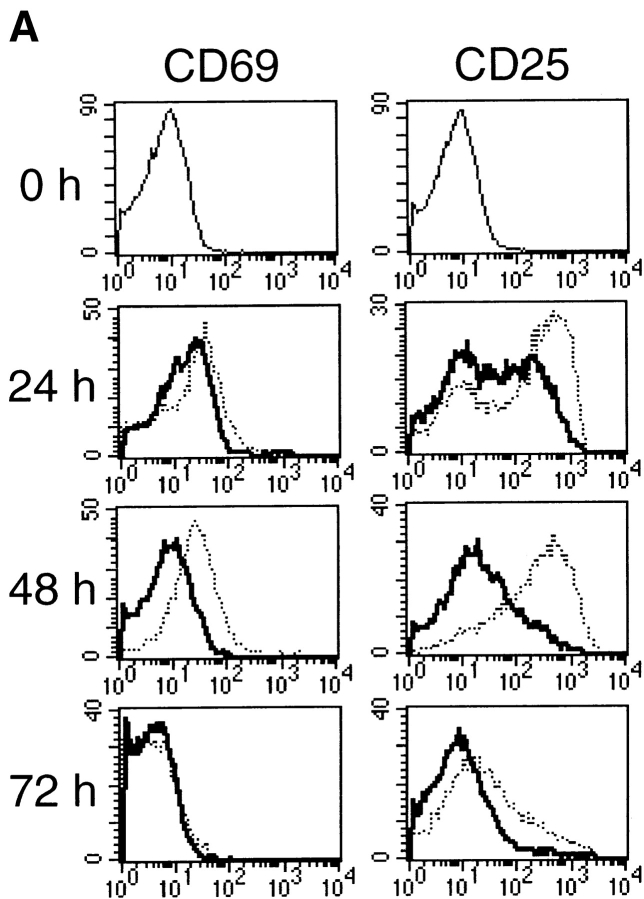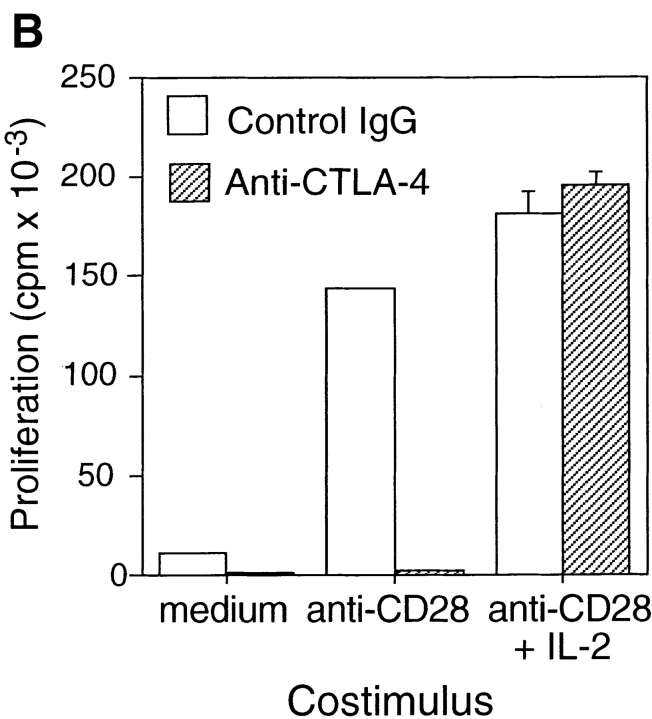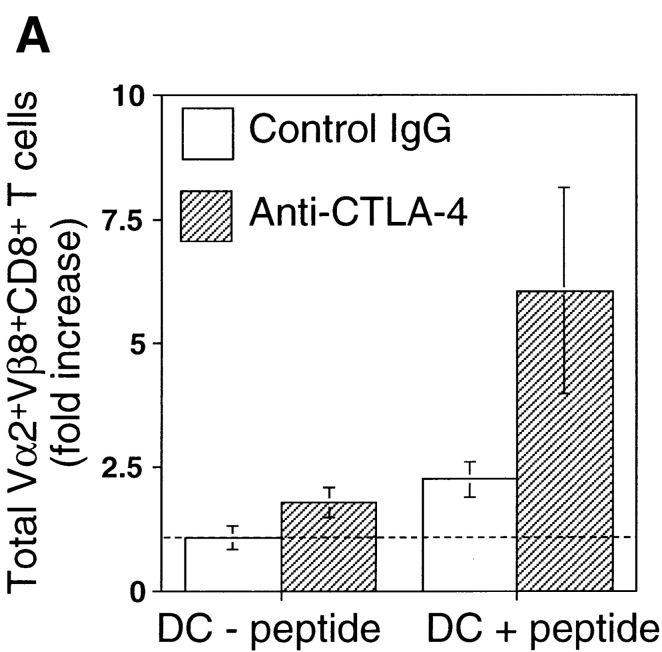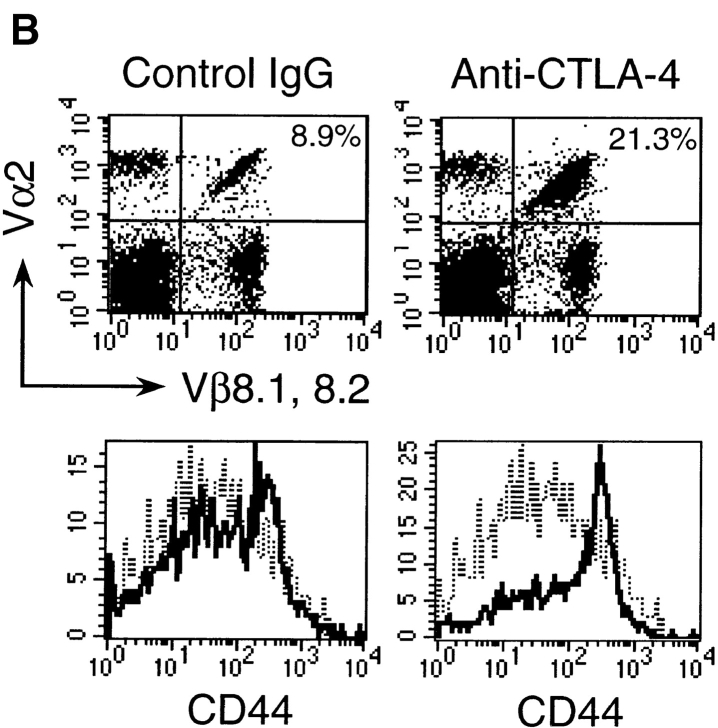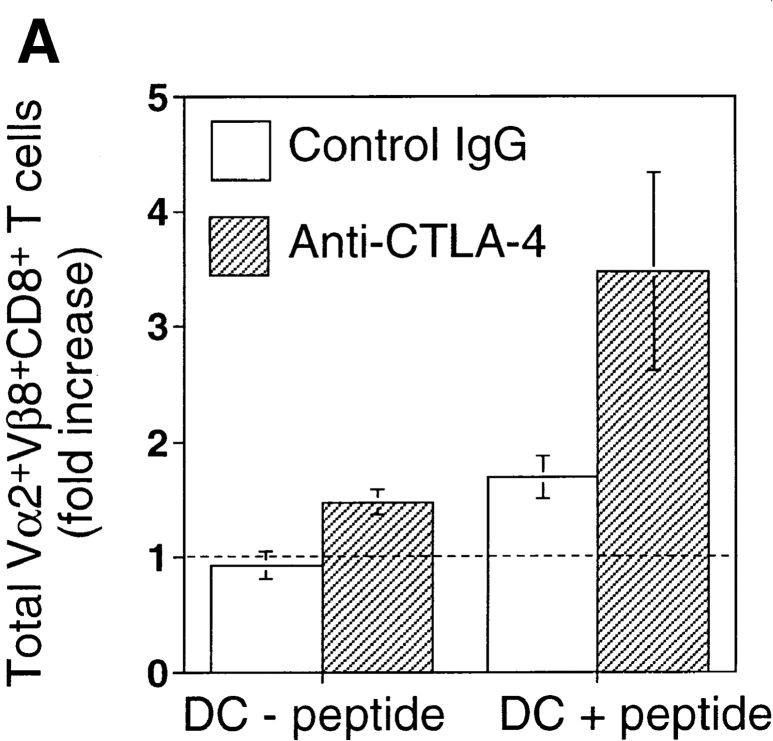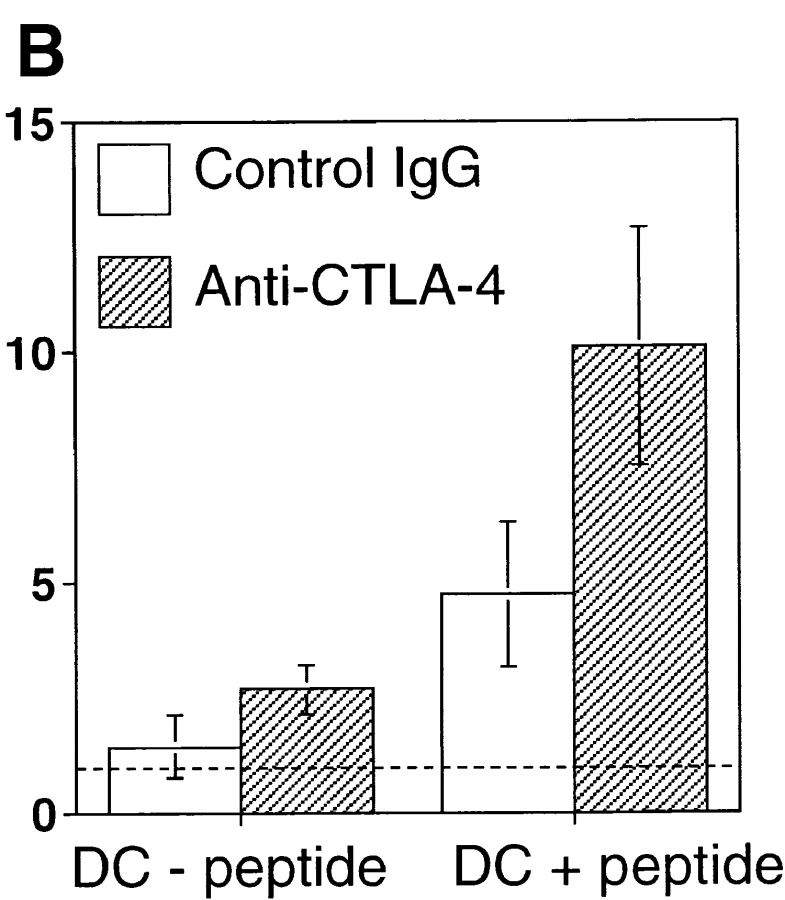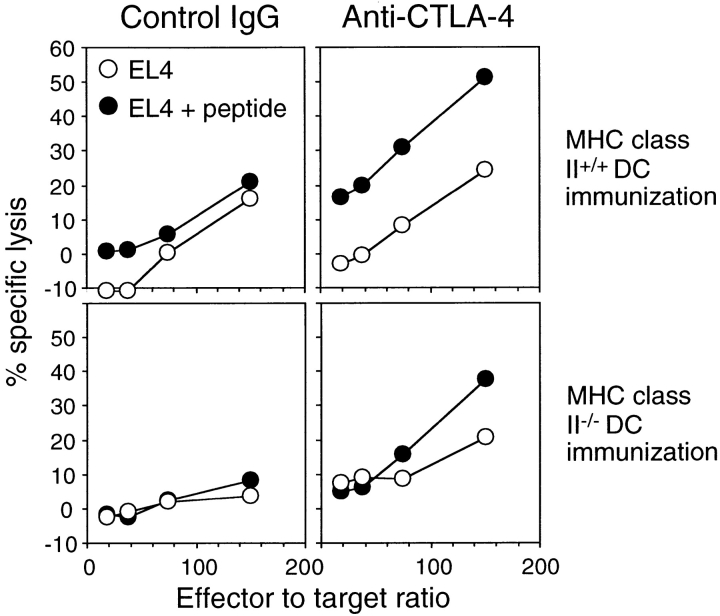Abstract
The mechanisms that regulate the strength and duration of CD8+ cytotoxic T cell activity determine the effectiveness of an antitumor immune response. To better understand the antitumor effects of anti-cytotoxic T lymphocyte–associated antigen 4 (CTLA-4) antibody treatment, we analyzed the effect of CTLA-4 signaling on CD8+ T cells in vitro and in vivo. In vitro, cross-linking of CTLA-4 on purified CD8+ T cells caused decreased proliferative responses to anti-CD3 stimulation and rapid loss of activation marker expression. In vivo, blockade of CTLA-4 by neutralizing anti–CTLA-4 mAb greatly enhanced the accumulation, activation, and cytotoxic activity of CD8+ T cells induced by immunization with Ag on dendritic cells (DC). This enhanced response did not require the expression of MHC class II molecules on DC or the presence of CD4+ T cells. These results demonstrate that CTLA-4 blockade is able to directly enhance the proliferation and activation of specific CD8+ T cells, indicating its potential for tumor immunotherapy even in situations in which CD4+ T cell help is limited or absent.
Keywords: CTLA-4 (CD152), CD8+ T cells, dendritic cells, CD4+ T cells, cytotoxicity
Naive T cells require two distinct signals to proliferate and differentiate into armed effector cells. Signal 1 is Ag-specific and generated by interaction of the TCR with antigenic peptide associated with MHC molecules on APC. Signal 2 is referred to as costimulatory because, while essential, it does not by itself induce any functional response in T cells. The most well characterized costimulatory signal is generated through the interaction of the T cell molecule CD28 with its ligands B7-1 and B7-2 on APC (1).
Negative costimulation also plays an important role in the regulation of T cell activation and peripheral T cell homeostasis. Interaction of B7 with cytotoxic T lymphocyte–associated antigen 4 (CTLA-4), expressed on activated T cells, mediates a negative signal that inhibits T cell proliferation (2). The importance of CTLA-4 in T cell proliferation is highlighted by the phenotype observed in CTLA-4–deficient mice, which is characterized by CD4+ T cell–driven polyclonal expansion of peripheral T cells, multiorgan lymphocytic infiltration, and death at three to four weeks of age (3–5).
In vitro, signals mediated by CTLA-4 decrease IL-2 production and IL-2 receptor expression and inhibit cell cycle progression (for review, see reference 2). In vivo, CTLA-4 signaling can be blocked by administration of anti–CTLA-4 mAb, resulting in enhanced T cell immune responses to Ag (6) or superantigen (7). Similarly, Th2-type immune responses to nematode parasite infection (8) and Th1-type immune responses to mycobacteria can be augmented by anti–CTLA-4 treatment (Kirman, J., K. McCoy, S. Hook, M. Prout, B. Delahunt, I. Orme, A. Frank, and G. Le Gros, manuscript submitted for publication), and autoimmune conditions are exacerbated (9–11). Antitumor immune responses are also augmented by preventing CTLA-4 function (12), as demonstrated by the enhanced tumor rejection in mice treated with anti–CTLA-4 mAb.
In this study, we have sought to define a potential mechanism for anti–CTLA-4–induced tumor immunity. We have reasoned that a B7-expressing cell must be involved, presenting tumor antigen and providing ligands for CTLA-4 on T cells and thus inducing incomplete or transient activation of antitumor T cells. Current understanding suggests that this cell is a dendritic cell (DC). Anti–CTLA-4 mAb may enhance the activation of Ag-specific CD8+ T cells via DC by either directly preventing the engagement of CTLA-4 on CD8+ T cells or enhancing CD4+ helper function. We find that anti–CTLA-4 treatment significantly enhances the expansion and cytotoxic activity of CD8+ T cells activated by Ag on DC and that this enhancement can occur independently of CD4+ T cell help.
Materials and Methods
Mice.
C57BL/6 mice were obtained from The Jackson Laboratory. Strain 318 TCR-transgenic mice (13) were provided by Prof. H. Pircher (University of Freiburg, Freiburg, Germany) and B6Aa0/Aa0 (MHC class II−/−) mice (14) by Dr. H. Blüthmann (Hoffmann-La Roche, Basel, Switzerland). All mice were bred and maintained at the Biomedical Research Unit of the Wellington School of Medicine.
In Vitro Culture Media and Reagents.
Cultures were in IMDM and additives were as described (8). The lymphocytic choriomeningitis virus glycoprotein peptide KAVYNFATM (LCMV33–41) was obtained from Chiron Mimotopes. Supernatant from the cell line IL2L6 was used as a source of human rIL-2.
Antibodies and FACS® Staining.
Anti–CTLA-4 clone UC10-4F10-11 (provided by Dr. J. Bluestone, University of Chicago, Chicago, IL), anti-CD3 (145-2C11), anti-CD28 (37.51), anti-CD8 (2.43), anti-CD4 (GK1.5), anti-CD11c (N418), anti-FcγRII (2.4G2), anti-Vβ8.1/8.2 (KJ16.133.18), and anti-CD44 (I42/5) were affinity purified from culture supernatants using protein G–Sepharose (Pharmacia Biotech) and conjugated to FITC or biotin. Anti-Vα2–PE mAb and streptavidin–Cy-Chrome were obtained from PharMingen. Control IgG was affinity purified from hamster serum using protein G–Sepharose. Cells were stained in PBS containing 2% FCS and 0.01% sodium azide as described (15).
In Vitro CTLA-4 Cross-linking Experiments.
Lymph node cell suspensions were layered onto a Percoll gradient (Pharmacia Biotech AB) and the high density cells taken from the interface of 60 and 70% Percoll layers. CD4+ and Ig+ cells were depleted by treatment with anti-CD4 mAb followed by anti-Ig magnetic bead adherence (Dynal A.S.). The remaining cell suspension contained 95% CD8+ T cells, with no detectable CD4+ T cells and <2% B220+ cells. For cross-linking experiments, 105 resting CD8+-enriched cells were cultured with 105 polystyrene beads coated with anti-CD3 and either anti–CTLA-4 or control IgG in the presence or absence of soluble anti-CD28 as described (16). Control cultures were provided with 50 U/ml human rIL-2. Proliferation was determined by 3H-TdR incorporation over the last 8 h of a 72-h culture.
Culture of Bone Marrow–derived DC and Ag Loading.
Bone marrow cells from C57BL/6 mice or MHC class II−/− mice were cultured in 20 ng/ml IL-4 and 20 ng/ml GM-CSF for 6–8 d as described (17). Cultures typically contained 90–100% DC as determined by FACS® staining with anti-CD11c mAb. DC were loaded with Ag by incubation in medium containing 10 μM LCMV33–41 for 2 h.
Adoptive Transfer and Immunization.
Lymph node cell suspensions were prepared from line 318 mice, and the percentage of T cells expressing transgenic TCR was determined by flow cytometry using anti-TCR Vα2 and anti-TCR Vβ8.1/8.2 mAb. The equivalent of 3–5 × 106 Vα2+Vβ8+ T cells were injected intravenously into C57BL/6 recipients, and on the same day, mice were given an intraperitoneal injection of 1 mg anti–CTLA-4 mAb or control IgG. 1 d later, recipients were immunized by subcutaneous injection of 105 LCMV33–41 peptide–loaded DC or untreated DC in IMDM. For each experiment, a group of adoptive transfer recipients was left unmanipulated to serve as a control. For experiments in MHC class II−/− recipients, the donor cell preparations were depleted of CD4+ and Ig+ cells as described above.
Direct Cytotoxicity Assays.
C57BL/6 mice received TCR-transgenic T cells, were treated with anti–CTLA-4 or control IgG, and were immunized with 3 × 104 DC as described above. 7 d after DC immunization, splenocytes were harvested, depleted of CD4+ and Ig+ cells, and tested for cytotoxic activity in vitro by JAM test on 5,000 labeled EL4 cells that had been incubated in the presence or absence of 1 μM LCMV33–41 peptide for 1 h at 37°C before the assay (18). All cultures were performed in triplicate.
Results
CTLA-4 Mediates a Negative Regulatory Signal to Purified CD8+ T Cells In Vitro.
We used anti–CTLA-4 mAb conjugated to polystyrene beads to examine the effect of CTLA-4 cross-linking on the activation and proliferation of purified resting CD8+ T cells in culture. Lymphocyte preparations from line 318 TCR-transgenic mice were depleted of CD4+ and Ig+ cells using Ab-coated magnetic beads. Enriched CD8+ T cells were cultured with beads coated with either anti-CD3 and anti–CTLA-4 or anti-CD3 and control IgG in the presence of a positive costimulatory signal provided by soluble anti-CD28. As shown in Fig. 1 A, after 24 h both control Ab–treated and anti– CTLA-4–treated cultures contained activated CD8+ T cells with markedly increased expression of the activation markers CD25 and CD69 as compared to resting cells. However, whereas expression of these activation markers was maintained until after 48 h in control cultures, it was rapidly lost in the presence of anti–CTLA-4. No increase in cell death was apparent in anti–CTLA-4–treated cultures as compared to control cultures (data not shown). Proliferation of CD8+ T cells in these cultures was assayed 64–72 h after activation (Fig. 1 B). In the presence of anti-CD28, control cultures were highly activated and showed significant levels of proliferation. In contrast, cross-linking of CTLA-4 with mAb-conjugated beads completely inhibited proliferation. The inhibitory function of anti–CTLA-4 was overridden by addition of exogenous IL-2. Therefore, the proliferative function of CD8+ T cells can be directly inhibited by signals mediated via CTLA-4. Similar results have been reported by Walunas et al. using CD8+ T cells from the TCR-transgenic strain 2C (19).
Figure 1.
Cross-linking of surface CTLA-4 molecules inhibits activation and proliferation of purified CD8+ T cells. Resting CD8+ T cells were isolated from the lymph nodes of line 318 transgenic mice and cultured with sterile polystyrene beads coated with either anti-CD3 and anti–CTLA-4 or anti-CD3 and control hamster IgG. Cultures were provided either no costimulus, soluble anti-CD28, or soluble anti-CD28 and rIL-2. (A) Expression of the activation markers CD25 and CD69 on resting CD8+ T cells and on CD8+ T cells cultured in the presence (thick line) or absence (dotted line) of anti–CTLA-4. (B) 3H-TdR uptake by CD8+ T cells cultured in the same conditions, measured 72 h after stimulation. Results are shown as the average of triplicate wells ± SE.
Anti–CTLA-4 mAb Treatment In Vivo Enhances DC-induced CD8+ T Cell Activation and Accumulation.
To determine whether CTLA-4 signals regulate the activation of CD8+ T cells in vivo, we examined the effect of a neutralizing anti– CTLA-4 mAb on the accumulation of specific CD8+ T cells in the lymph nodes of mice immunized with Ag-loaded DC. An adoptive transfer model was used (15) in which nonmanipulated C57BL/6 hosts received 5 × 106 TCR-transgenic T cells from strain 318 mice. These T cells are specific for LCMV33–41 in association with H-2Db and can be identified by their Vα2+Vβ8+CD8+ phenotype. Anti– CTLA-4 mAb or control IgG was administered intraperitoneally at the time of adoptive transfer, followed by DC loaded with LCMV33–41 peptide on day 1. Control animals received either DC that had not been loaded with Ag or no DC immunization at all. Activation and accumulation of Vα2+Vβ8+CD8+ T cells in the draining lymph nodes were examined on day 5 after immunization, as preliminary experiments showed that both responses were maximal on this day (data not shown). The data in Fig. 2 are presented as fold increase in the total number of Vα2+Vβ8+CD8+ T cells in immunized mice over the number of the same cells in animals that were not immunized. This is because the fold increase in Vα2+Vβ8+CD8+ T cells was reproducible in different experiments, whereas the absolute cell number varied. In control IgG–treated animals, an average 2.4-fold increase in the number of Vα2+Vβ8+CD8+ T cells was observed in response to Ag-loaded DC, whereas immunization with DC without Ag failed to induce any increase. Significantly, when animals were treated with anti–CTLA-4 mAb, the Ag-induced accumulation was greater, with an average sixfold increase observed. This reflected both an increase in the proportion of Vα2+Vβ8+CD8+ T cells and an increase in the total number of lymph node cells (twofold). Immunization with Ag-loaded DC induced increased CD44 expression on a significant proportion of Vα2+Vβ8+ T cells, and this proportion was greatly increased in animals treated with anti–CTLA-4 mAb (Fig. 2). Importantly, increased CD44 expression was strictly Ag dependent and was not detected on cells not expressing the Vα2+Vβ8+ receptor. Interestingly, a twofold increase in the cellularity of the draining lymph node, with no increase in the percentage of Vα2+Vβ8+CD8+ cells, was observed in mice treated with anti–CTLA-4 and immunized with DC only, resulting in an increase in the absolute number of Vα2+Vβ8+ cells. The increased cellularity was immunization related, as it was not observed in nondraining lymph nodes. No increased expression of CD44 or other activation markers was observed on these Vα2+Vβ8+ cells (not shown), indicating that blockade of CTLA-4 signals was not sufficient to induce T cell activation in the absence of Ag. Taken together, these results suggest that inhibition of CTLA-4–mediated signaling results in enhanced Ag-specific proliferation of CD8+ T cells in vivo.
Figure 2.
Treatment with anti–CTLA-4 mAb augments the accumulation and activation of adoptively transferred CD8+ T cells in the lymph nodes of mice immunized with DC. (A) Numbers of Vα2+Vβ8+CD8+ cells were determined in the lymph nodes of experimental mice (n = 4–8) 5 d after immunization with DC and are presented as the average ± SE fold increase in the total number of Vα2+Vβ8+CD8+ T cells over the corresponding nonimmunized adoptive transfer controls. Combined results from two experiments are shown. Numbers of Vα2+Vβ8+CD8+ T cells in nonimmunized adoptive transfer controls varied between 3 × 104 and 105 over two different experiments. Mice received treatment with anti–CTLA-4 mAb or control IgG as indicated. (B) Representative stainings from mice immunized with DC + Ag. CD44 expression on gated Vα2+Vβ8+ cells was determined by triple staining and FACS® analysis.
Enhanced CD8+ T Cell Activation In Vivo by Anti–CTLA-4 mAb Treatment Is Not a Result of Increased CD4+ T Helper Function.
It was possible that the enhanced CD8+ T cell activation induced by anti–CTLA-4 mAb treatment was due to increased helper function of CD4+ T cells. To examine this possibility, we repeated the DC immunization experiments using MHC class II−/− DC, which are unable to present Ag to CD4+ T cells and elicit T cell help. MHC class II−/− mice were also used as immunization recipients, as in these mice, no T cell help would be available if Ag was transferred from the injected DC to host APC.
As shown in Fig. 3, immunization with MHC class II−/− DC loaded with LCMV33–41 peptide induced selective accumulation of Vα2+Vβ8+CD8+ T cells in the draining lymph nodes of MHC class II+/+ and MHC Class II−/− mice. More importantly, treatment with anti–CTLA-4 mAb significantly enhanced the accumulation of Vα2+Vβ8+CD8+ T cells (Fig. 3) and their expression of CD44 (not shown), regardless of the expression of MHC class II on host APC. Again, as for Fig. 2, treatment with anti–CTLA-4 caused an increase in the cellularity of the draining lymph node in mice immunized with DC only; however, the percentage of Vα2+Vβ8+CD8+ cells was not increased compared to controls nor was their expression of activation markers altered. These results suggest that the enhanced accumulation of Vα2+Vβ8+ T cells observed with anti–CTLA-4 treatment in DC-immunized mice is not dependent on the provision of CD4+ T cell help. We conclude that CD8+ T cells can be directly regulated in vivo by signals mediated via CTLA-4 molecules.
Figure 3.
Treatment with anti–CTLA-4 mAb augments the accumulation of CD8+ T cells in the lymph nodes of immunized mice regardless of the availability of T cell help. Groups of C57BL/6 (A) or MHC class II−/− (B) recipient mice (n = 4–11) received 5 × 106 Vα2+Vβ8+CD8+ T cells from line 318 transgenic donors, were treated with either anti–CTLA-4 mAb or control IgG, and were immunized with MHC class II−/− DC as described in the Fig. 2 legend. Combined data are shown as for Fig. 2. The number of Vα2+Vβ8+CD8+ T cells in nonimmunized adoptive transfer controls varied between 3 × 104 and 1.5 × 105 over three different experiments for the data in A and between 1.9 × 104 and 2.4 × 104 over two different experiments for the data in B.
Anti–CTLA-4 mAb Treatment In Vivo Enhances Ag-specific Cytotoxicity Measured In Vitro.
To determine whether in vivo treatment with anti–CTLA-4 mAb affects the effector function of CD8+ T cells, we assayed cytotoxic activity in mAb-treated adoptive transfer recipients that had been immunized with DC. Spleen cells were recovered 7 d after immunization, depleted of CD4+ T cells and Ig+ cells, and assayed directly on LCMV33–41 peptide–coated EL4 targets. As is seen in Fig. 4, Ag-specific cytotoxicity was barely detectable when CD8+ effector cells were prepared from DC-immunized, control IgG–treated mice. Therefore, the cytotoxic activity induced by DC immunization was below the threshold of detection by this technique. In contrast, in vivo treatment with anti–CTLA-4 mAb resulted in a measurable increase in specific cytotoxicity, with 50% lysis observed at an E/T ratio of 150:1 when MHC class II+/+ DC were used for immunization. When MHC class II−/− DC were used, 35% lysis was observed. Increased cytotoxic activity of effector CD8+ T cells in the anti–CTLA-4–treated groups was apparent even when the E/T ratios were adjusted for the percentage of Vα2+Vβ8+ cells (data not shown). These results indicate that CTLA-4–mediated signals regulate the cytotoxic activity of CD8+ T cells, also in the absence of CD4+ help.
Figure 4.
Treatment with anti–CTLA-4 mAb during in vivo immunization with DC enhances the direct, Ag-specific cytotoxicity measured in vitro. C57BL/6 recipient mice received 5 × 106 Vα2+Vβ8+CD8+ T cells from line 318 transgenic donors, were treated with either control IgG or anti–CTLA-4 mAb, and were immunized with 3 × 104 LCMV33–41 peptide–loaded DC from C57BL/6 or MHC class II−/− mice as described for Fig. 2. 7 d after immunization, spleen cell suspensions were prepared and depleted of CD4+ T cells and Ig+ cells by magnetic adherence. Cytotoxic activity was measured in vitro by JAM test on EL4 targets or on EL4 + LCMV33–41 peptide.
Discussion
In this paper, we show that CD8+ T cell responses induced by Ag presented on DC are amplified when CTLA-4–dependent signaling is inhibited in vivo. While anti– CTLA-4 mAb treatment was known to enhance several kinds of T cell immune responses (6–11), it had not been previously reported that increased CD8+ T cell activation is also observed when DC are used as APC, a finding that may have significant implications for the use of anti– CTLA-4 in tumor immunotherapy.
We investigated whether anti–CTLA-4 enhanced the activity of CD8+ T cells directly or by increasing the availability of CD4+ T cell help. To this purpose, we carried out experiments in which the potential contribution of CD4+ T cells to the CD8+ T cell response was progressively reduced. We observed augmented CD8+ T cell responses regardless of the availability of CD4+ T cells, indicating that CD4+ T cells were not critical to the observed effect. As also reported by Walunas et al. (19), a purified cell culture system confirmed that CD8+ T cells could respond directly to CTLA-4–mediated signals in vitro. However, although it is clear that the effects of anti–CTLA-4 we have observed are independent of CD4+ T cell help, CD4+ T cells are thought to be necessary for the activation of DC and for the productive development of a CD8+ T cell response (20). Because we could observe good CD8+ T cell responses even in the absence of CD4+ T cells, we must conclude that our DC were sufficiently activated before injection to be able to induce good CD8+ T cell priming.
The findings reported in this paper are relevant to the described enhancement of tumor immunity induced by in vivo treatment with anti–CTLA-4 mAb (12). Treatment with anti–CTLA-4 mAb in vivo is thought to block the delivery of a negative signal, mediated by B7 ligands on B7-expressing cells. Because tumor cells are generally B7−, a third cell type must be providing B7 in this system. Bone marrow–derived APC, presumably DC, have been reported to take up and present self Ag (21) as well as tumor Ag (22) from peripheral tissues in physiological situations. We thus hypothesized that tumor immunity induced by anti–CTLA-4 treatment is most likely due to enhanced T cell activation by tumor antigen presented by DC. In this paper, we show that both CD8+ T cell activation and specific cytotoxic activity induced by immunization with DC are amplified in the presence of anti–CTLA-4 mAb, possibly resulting in the tumor immunity described by Leach et al. (12). Our results also imply that tumors in which Ag fails to gain access to a DC, because of either poor antigenicity or limited DC presence in the tumor, may fail to respond to anti–CTLA-4 treatment. Conversely, manipulations which increase local inflammation and therefore access of tumor Ag to DC (23), or tumor vaccination procedures, could become more effective if used in combination with anti–CTLA-4 treatment (24).
As in the case of CTLA-4–deficient mice (25), we could observe no spontaneous T cell activation in the absence of Ag when CTLA-4 signaling was blocked. Surprisingly, however, we observed that lymph node cellularity was increased by anti–CTLA-4 treatment even after immunization with DC only. This increase was restricted to the draining lymph nodes, indicating that it was immunization related. DC have been reported to induce Ca2+ responses in T cells in the absence of Ag (26). This low level of stimulation may be amplified by the removal of CTLA-4 signals.
In conclusion, blockade of CTLA-4 directly enhances the ability of CD8+ T cells to respond to Ag presented on DC, amplifying their expansion and accumulation in lymphoid organs and their cytotoxic activity. This finding may help explain the antitumor effect of anti–CTLA-4 mAb treatment, and, if extended to CD4+ T cells, the autoimmune phenotype observed in CTLA-4–deficient mice.
Acknowledgments
We thank the personnel of the Wellington Medical School Biomedical Research Unit for animal husbandry.
This work was supported by grants from the Cancer Society of New Zealand and an equipment grant from the New Zealand Lottery Board. J.H. Fraser is the New Zealand Cancer Research Institute Trust Scholar, G. Le Gros is a Wellcome Trust Senior Research Fellow, and F. Ronchese is recipient of a Wellington Medical Research Foundation Malaghan Senior Fellowship.
Footnotes
K. McCoy's present address is Institute for Experimental Immunology, University of Zürich, Schmelzbergstrasse 12, CH-8091 Zürich, Switzerland.
K.D. McCoy and I.F. Hermans contributed equally to this study.
References
- 1.Bluestone JA. New perspectives of CD28-B7-mediated T cell costimulation. Immunity. 1995;2:555–559. doi: 10.1016/1074-7613(95)90000-4. [DOI] [PubMed] [Google Scholar]
- 2.Thompson CB, Allison JP. The emerging role of CTLA-4 as an immune attenuator. Immunity. 1997;7:445–450. doi: 10.1016/s1074-7613(00)80366-0. [DOI] [PubMed] [Google Scholar]
- 3.Waterhouse P, Penninger JM, Timms E, Wakeham A, Shahinian A, Lee KP, Thompson CB, Griesser H, Mak TW. Lymphoproliferative disorders with early lethality in mice deficient in CTLA-4. Science. 1995;270:985–988. doi: 10.1126/science.270.5238.985. [DOI] [PubMed] [Google Scholar]
- 4.Tivol EA, Borriello F, Schweitzer AN, Lynch WP, Bluestone JA, Sharpe AH. Loss of CTLA-4 leads to massive lymphoproliferation and fatal multiorgan tissue destruction, revealing a critical negative regulatory role of CTLA-4. Immunity. 1995;3:541–547. doi: 10.1016/1074-7613(95)90125-6. [DOI] [PubMed] [Google Scholar]
- 5.Chambers CA, Sullivan TJ, Allison JP. Lymphoproliferation in CTLA-4-deficient mice is mediated by costimulation-dependent activation of CD4+T cells. Immunity. 1997;7:885–895. doi: 10.1016/s1074-7613(00)80406-9. [DOI] [PubMed] [Google Scholar]
- 6.Kearney ER, Walunas TL, Karr RW, Morton PA, Loh DY, Bluestone JA, Jenkins MK. Antigen-dependent clonal expansion of a trace population of antigen-specific CD4+T cells in vivo is dependent on CD28 costimulation and inhibited by CTLA-4. J Immunol. 1995;155:1032–1036. [PubMed] [Google Scholar]
- 7.Krummel MF, Sullivan TJ, Allison JP. Superantigen responses and costimulation: CD28 and CTLA-4 have opposing effects on T cell expansion in vitro and in vivo. Int Immunol. 1996;8:519–523. doi: 10.1093/intimm/8.4.519. [DOI] [PubMed] [Google Scholar]
- 8.McCoy KD, Camberis M, Le Gros G. Protective immunity to nematode infection is induced by CTLA-4 blockade. J Exp Med. 1997;186:183–187. doi: 10.1084/jem.186.2.183. [DOI] [PMC free article] [PubMed] [Google Scholar]
- 9.Karandikar NJ, Vanderlugt CL, Walunas TL, Miller SD, Bluestone JA. CTLA-4: a negative regulator of autoimmune disease. J Exp Med. 1996;184:783–788. doi: 10.1084/jem.184.2.783. [DOI] [PMC free article] [PubMed] [Google Scholar]
- 10.Lühder F, Högland P, Allison JP, Benoist C, Mathis D. Cytotoxic T lymphocyte–associated antigen 4 (CTLA-4) regulates the unfolding of autoimmune diabetes. J Exp Med. 1998;187:427–432. doi: 10.1084/jem.187.3.427. [DOI] [PMC free article] [PubMed] [Google Scholar]
- 11.Perrin PJ, Maldonado JH, Davis TA, June CH, Racke MK. CTLA-4 blockade enhances clinical disease and cytokine production during experimental allergic encephalomyelitis. J Immunol. 1996;157:1333–1336. [PubMed] [Google Scholar]
- 12.Leach DR, Krummel MF, Allison JP. Enhancement of antitumor immunity by CTLA-4 blockade. Science. 1996;271:1734–1736. doi: 10.1126/science.271.5256.1734. [DOI] [PubMed] [Google Scholar]
- 13.Pircher H, Buerki K, Lang R, Hengartner H, Zinkernagel RM. Tolerance induction in double specific T-cell receptor transgenic mice varies with antigen. Nature. 1989;342:559–561. doi: 10.1038/342559a0. [DOI] [PubMed] [Google Scholar]
- 14.Köntgen F, Süss G, Stewart C, Steinmetz M, Blüthmann H. Targeted disruption of the MHC class II Aagene in C57BL/6 mice. Int Immunol. 1993;5:957–964. doi: 10.1093/intimm/5.8.957. [DOI] [PubMed] [Google Scholar]
- 15.Hermans IF, Daish A, Yang J, Ritchie DS, Ronchese F. Antigen expressed on tumor cells fails to elicit an immune response, even in the presence of increased numbers of tumor-specific cytotoxic T lymphocyte precursors. Cancer Res. 1998;58:3909–3917. [PubMed] [Google Scholar]
- 16.Fraser, J.H., M. Rincon, K.D. McCoy, and G. Le Gros. 1999. CTLA-4 ligation attenuates AP-1, NFAT and NFκB activity in activated T cells. Eur. J. Immunol. In press. [DOI] [PubMed]
- 17.Garrigan K, Moroni-Rawson P, McMurray C, Hermans I, Abernethy N, Watson J, Ronchese F. Functional comparison of spleen dendritic cells and dendritic cells cultured in vitrofrom bone marrow precursors. Blood. 1996;88:3508–3512. [PubMed] [Google Scholar]
- 18.Hermans IF, Daish A, Moroni-Rawson P, Ronchese F. Tumor peptide-pulsed dendritic cells isolated from spleen or cultured in vitro from bone marrow precursors can provide protection against tumor challenge. Cancer Immunol Immunother. 1997;44:341–347. doi: 10.1007/s002620050392. [DOI] [PMC free article] [PubMed] [Google Scholar]
- 19.Walunas TL, Bakker CY, Bluestone JA. CTLA-4 ligation blocks CD28-dependent T cell activation. J Exp Med. 1996;183:2541–2550. doi: 10.1084/jem.183.6.2541. [DOI] [PMC free article] [PubMed] [Google Scholar]
- 20.Lanzavecchia A. Immunology. Licence to kill. Nature. 1998;393:413–414. doi: 10.1038/30845. [DOI] [PubMed] [Google Scholar]
- 21.Kurts C, Heath WR, Carbone FR, Allison J, Miller JF, Kosaka H. Constitutive class I–restricted exogenous presentation of self antigens in vivo. J Exp Med. 1996;184:923–930. doi: 10.1084/jem.184.3.923. [DOI] [PMC free article] [PubMed] [Google Scholar]
- 22.Huang AY, Golumbek P, Ahmadzadeh M, Jaffee E, Pardoll D, Levitsky H. Role of bone marrow- derived cells in presenting MHC class I-restricted tumor antigens. Science. 1994;264:961–965. doi: 10.1126/science.7513904. [DOI] [PubMed] [Google Scholar]
- 23.Dranoff G, Jaffee E, Lazenby A, Golumbek P, Levitsky H, Brose K, Jackson V, Hamada H, Pardoll D, Mulligan RC. Vaccination with irradiated tumor cells engineered to secrete murine granulocyte-macrophage colony-stimulating factor stimulates potent, specific, and long-lasting anti-tumor immunity. Proc Natl Acad Sci USA. 1993;90:3539–3543. doi: 10.1073/pnas.90.8.3539. [DOI] [PMC free article] [PubMed] [Google Scholar]
- 24.Hurwitz AA, Yu TF, Leach DR, Allison JP. CTLA-4 blockade synergizes with tumor-derived GM-CSF for treatment of an experimental mammary carcinoma. Proc Natl Acad Sci USA. 1998;95:10067–10071. doi: 10.1073/pnas.95.17.10067. [DOI] [PMC free article] [PubMed] [Google Scholar]
- 25.Waterhouse P, Bachmann MF, Penninger JM, Ohashi PS, Mak TW. Normal thymic selection, normal viability and decreased lymphoproliferation in T cell receptor-transgenic CTLA-4-deficient mice. Eur J Immunol. 1997;27:1887–1892. doi: 10.1002/eji.1830270811. [DOI] [PubMed] [Google Scholar]
- 26.Delon J, Bercovici N, Raposo G, Liblau R, Trautmann A. Antigen-dependent and -independent Ca2+responses triggered in T cells by dendritic cells compared with B cells. J Exp Med. 1998;188:1473–1484. doi: 10.1084/jem.188.8.1473. [DOI] [PMC free article] [PubMed] [Google Scholar]



